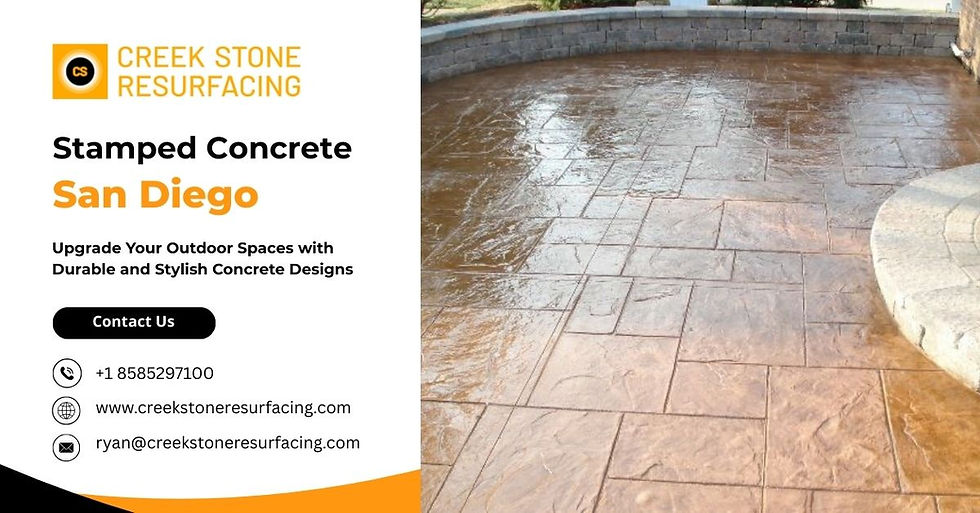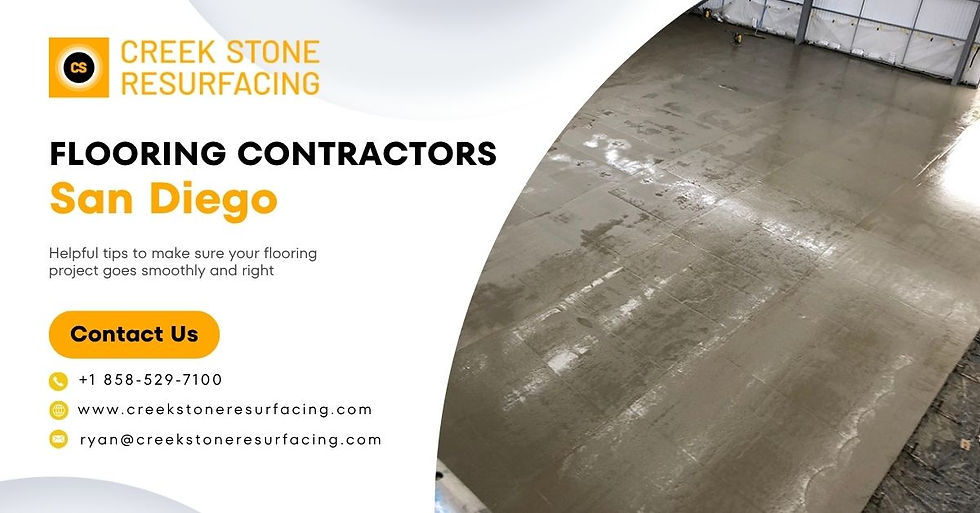Concrete Polishing Explained: Benefits, Process, and Finishes
- james85611
- Aug 4
- 4 min read

Concrete has evolved from a purely functional material to a key element in modern design. From minimalist homes to upscale commercial properties, concrete polishing is gaining popularity for clean look, durability, and cost-effectiveness. If you're considering this option for your next flooring project, this guide will explain the key benefits, outline the polishing process, and showcase the most popular finish options available today.
What Is Concrete Polishing?
It is a mechanical process that smooths and refines a concrete surface using progressively finer grinding tools, often embedded with industrial diamonds. Polishing helps in improving the look and durability of the concrete floor.
Benefits of Polished Concrete Floors
Concrete polishing isn’t just a design trend; it’s a practical, sustainable solution for many types of spaces. Here are some of the top benefits:
1. Durability and Longevity
Polished concrete is incredibly tough. Once the concrete is hardened, it is resistant to heavy foot traffic. This makes it ideal for high-traffic areas such as warehouses, schools, offices, and kitchens.
2. Low Maintenance
Unlike wood or tile floors that require regular waxing, resealing, or grout cleaning, polished concrete is low-maintenance. Routine sweeping and damp mopping are usually enough to keep it looking great.
3. Cost-Effective
Polished concrete is cost-efficient in both the short and long term. It uses the existing slab (no need for additional flooring materials), and maintenance costs are minimal over time. It’s a smart investment for both residential and commercial properties.
4. Eco-Friendly Flooring Option
Concrete polishing uses existing materials, minimizing waste and reducing the need for added coatings or adhesives. Its high light reflectivity also prevents the need for artificial lighting, making it more energy-efficient.
5. Design Versatility
Polished concrete can be customized to a wide variety. From industrial gray to decorative stained patterns, it offers nearly unlimited design potential. You can even expose the underlying aggregate for a textured, terrazzo-like effect.
The Concrete Polishing Process
It is a detailed, multi-step process that requires specialized equipment and professional expertise. Here’s a breakdown of what to expect:
Step 1: Surface Preparation
Before polishing begins, the concrete surface is thoroughly cleaned. The old concrete coatings and adhesives are removed for a better grip. Cracks and holes are patched to ensure a smooth starting point.
Step 2: Grinding
Grinding is the first stage of smoothing the concrete. Diamond segments are used to grind and remove the extra layers of the floor. This step can also expose aggregates if a decorative finish is desired.
Step 3: Densifying
To harden the concrete, a chemical densifier is applied to it. This improves the floor’s durability and helps it hold a better polish. Densifiers react with the calcium hydroxide in the concrete to form a more solid surface.
Step 4: Honing
Finer diamond abrasives are used to hone the surface, removing minor scratches from the initial grind and beginning the polishing process. At this stage, the floor starts to take on a smoother, satin-like feel.
Step 5: Polishing
Polishing continues with increasingly fine abrasives, typically from 400 to 3,000 grit depending on the desired level of gloss. The more passes that are made with finer pads, the shinier the surface becomes.
Step 6: Sealing (Optional)
Although polished concrete is naturally dense and stain-resistant, a penetrating sealer may be applied for extra protection, especially in kitchens, bathrooms, or industrial spaces prone to spills.
Popular Polished Concrete Finishes
The beauty of concrete polishing lies in its versatility. Here are some of the most common finishes available:
1. Matte Finish (Low Gloss)
Perfect for residential or minimalist designs, a matte finish offers a soft, natural look. It offers the durability of polished concrete without too much shine, making it ideal for understated interiors.
2. Satin or Semi-Gloss Finish
This medium-gloss finish reflects more light and adds a subtle shine to the floor. It’s one of the most popular choices for retail spaces, offices, and living rooms because of its high functionality.
3. High-Gloss Finish
Highly reflective and sleek, this finish resembles polished stone or marble. It’s often used in luxury homes, showrooms, and commercial spaces where a dramatic visual impact is desired.
4. Exposed Aggregate Finish
For a textured, decorative effect, some floors are polished enough to expose the internal stone or gravel aggregate. This terrazzo-like finish offers a unique and visually striking appearance.
5. Stained and Polished Concrete
Combine polishing with concrete staining or dyeing to add color and artistic flair. Popular in restaurants, offices, and retail environments, stained polished concrete allows for logos, patterns, and color gradients to be incorporated directly into the floor.
Where Can You Use Polished Concrete?
Polished concrete is versatile and works well in a wide range of environments:
Residential: kitchens, basements, living rooms, and garages
Commercial: retail stores, offices, hotels, and restaurants
Industrial: warehouses, factories, and distribution centers
Public: schools, museums, airports, and event venues
Final Thoughts
Concrete polishing is more than just a finishing touch; it’s a smart, sustainable, and stylish flooring solution. Whether you're renovating a home or upgrading a commercial space, polished concrete offers long-term durability, design flexibility, and low maintenance.
By understanding the benefits, the polishing process, and the range of available finishes, you can make an informed decision that adds beauty and value to your space. Ready to transform your floors? Contact a professional concrete polishing contractor to get started.



Comments